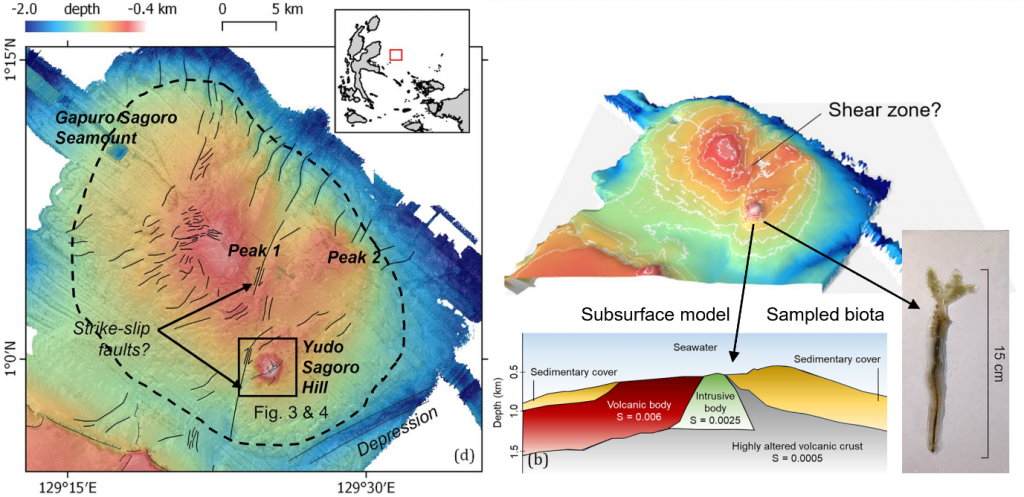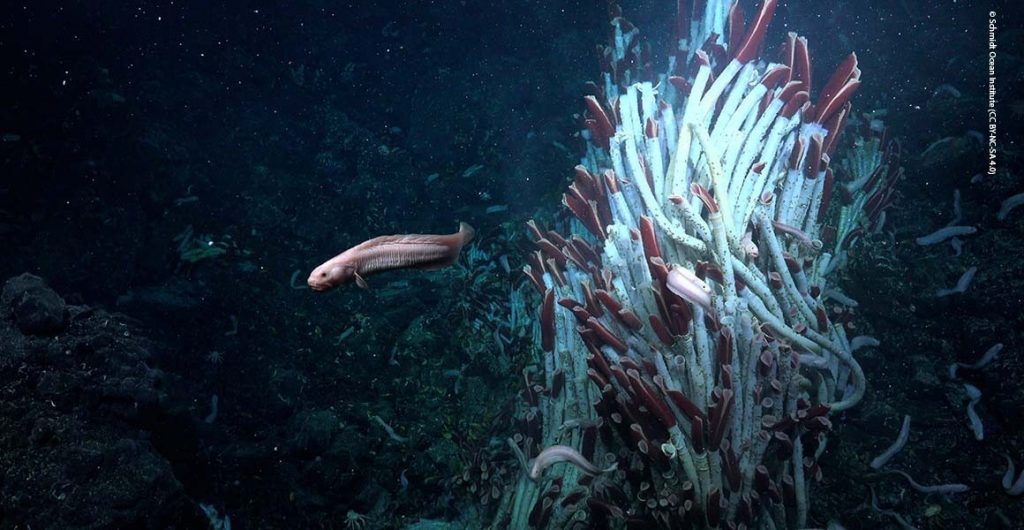Written by: Gabriella Alodia
Gapuro Sagoro means “gate of the sea” in Indonesian (indigenous) language, referring to the Pacific Ocean entering Indonesian waters from the northeast through this “gate”.
– Pushidrosal, 2022, documented in the GEBCO Undersea Feature Names Digital Gazetteer
Tuesday, 3 August 2021, has been a historic day for the advancement of Indonesia’s deep-water exploration. On a very clear day in an Indonesian naval base port, the Indonesian Chief of Navy officially launched KRI Spica 934, the second Indonesian navy hydro-oceanographic auxiliary ship, for the Jalacitra I-2021 “Aurora” expedition. The expedition was initiated by the Indonesian Navy Hydro-Oceanographic Centre (Pushidrosal) to map underwater hazards in Halmahera waters, as reported in the Indonesian Notice to Mariners in the 1950s, in the form of rapid underwater movements and boiling waters. Researchers from multiple governmental and academic institutions, including Institut Teknologi Bandung, discovered a 615-m-tall conical feature on top of a subdued 31-km-wide and 2-km-tall structure now known as the Gapuro Sagoro Seamount. The conical feature, now known as the Yudo Sagoro Hill, is interpreted to be a site where reactivation of a hydrothermal system occurred. But what is a hydrothermal system anyway?
A hydrothermal system, commonly indicated by the presence of an ‘underwater chimney’ exerting smoke, is a system in which seawater seeps into the oceanic crust through fissures and fractures resulting from tectonic activities. The drawing down of cold seawater toward hot magma or a newly solidified hot rock caused heat exchange, resulting in a plume of buoyant fluid that rises rapidly and discharges to the seafloor in the form of a hydrothermal vent. These vents serve as a fertile ground for the emergence and growth of novel ecosystems, including tubeworms, mussels, shrimps, crabs, and deep-sea octopus. The fact that these hydrothermal vent ecosystems could be found and are striving at depths of thousands of metres led scientists to hypothesize that the environment might mimic the early life on Earth.
Yudo Sagoro Hill was first indicated during the first leg of the expedition. Several magnetic lines made clear that the structure comprises at least a layer of magmatic rock, despite the fact that no rock sample was successfully obtained during the expedition. However, seafloor sampling managed to extract sediments and even living seafloor biota, illustrating favourable living conditions over the conical structure. After the completion of the second leg, it was clear that the hill was part of an even larger structure that seems to have been subdued. A north-south bearing undersea fault indicated in the centre of the larger structure strengthened the interpretation that the hill was a manifestation of hydrothermal reactivation through the drawing of seawater into the fractures of the fault.

Visual impression of the Gapuro Sagoro Seamount, including a model of the sub-surface structure and a deep-sea worm sampled from the Yudo Sagoro Hill. Images are compiled from Alodia et al. (2023).
Mapping the seafloor in deep-water areas requires high-end technology and a dedicated survey vessel with a transducer the size twice of an adult human. All these fancy instruments and a dedicated survey team – what for?
In the world of marine geoscience and biology, hydrothermal vents are still regarded as frontier areas for scientific discoveries. Up to this point, these vents are mostly found in the high seas, where little to no jurisdiction for scientific expeditions applies. Meanwhile, the deep-water areas of the Indonesian territorial sea remain a little-known territory for hydrothermal activities. The unique tectonic setting only found within our own ‘playground’ might be a place for the emergence of marine species that we never knew existed or even considered ‘liveable’ for rare or ancient species. High-resolution bathymetric mapping would also lead us to understand the magmatic and tectonic processes that occurred in the oceanic and even continental crust below the waters, presenting us with another potential of scientific breakthroughs.

Distinct animal communities found in hydrothermal vents and underneath them. Image is courtesy of Schmidt Ocean Institute, licensed under CC BY-NC-SA 4.0 via Nature.
Scientific discoveries will also serve as evidence of our capability to collaborate as a nation and, more broadly, as citizens of the world. It requires multiple techniques that go beyond a certain discipline. The potential of scientific discoveries could ignite and accelerate the development of supporting infrastructures in the form of hardware (e.g., remotely operated vehicles, surveying instruments, research vessels), software (e.g., acquisition, processing, and visualisation software), and even facilitate transfer of knowledge and technology between institutions around the globe of the same spirit. Ultimately, we can always talk about the practicalities of science and their direct impact on our life. But most of the time, we often forget how joyful and exciting it is to discover new or even foreign things in life. The discoveries often come with an unparalleled sense of camaraderie built among the researchers and supporters involved, as we managed to leave a lasting mark on our short human life. That would be the pride that I wish my children, and the next generations, could experience.
Further reading:
Alodia, G., Nurhidayat, Sobarudin, D. P., Adrianto, D., Dwinovantyo, A., Solikin, S., Hanafi, M., Pamumpuni, A., Kurniawan, I. A., Poerbandono, Green, C. M., & McCaig, A. M. (2023). Discovery of a conical feature in Halmahera waters, Indonesia: traces of a late-stage hydrothermal activity. Geoscience Letters, 10(1), 47. https://doi.org/10.1186/s40562-023-00302-w
